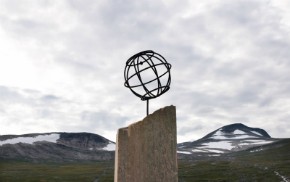Warm and warmer: One degree can be a big difference

Sleet stung my face as I squinted to navigate the jagged strata of streets glazed by semifrozen furrows of ice and snow. I muttered a mix of blessings for studded bike tires and curses for cars that pass too close and too fast. Couldn’t the drivers see the child trailer I was pulling?
This past winter, my first in Norway, I commuted to my two-year-old’s day care by bike. I knew limited daylight was part of the deal in winter in Norway, and I didn’t curse the darkness; I just flicked on my helmet-mounted headlamp. What I did curse—along with the drivers—was the confounding climate. There’s a saying here: There’s no such thing as bad weather, only bad clothing.
Read our latest issue or browse back issues.
Since settling in Oslo, I’ve had to make some significant wardrobe adjustments—but they haven’t been snowshoes and puffy down parkas. My main investment has been in head-to-toe Gore-Tex rain gear.
Norway just had its warmest winter on record, following a year of record-high temperatures and extreme weather events. While the ninth circle of Dante’s hell is frozen solid, he could have deepened Satan’s torment by placing him on a stationary bicycle waist-deep in a pool of slush that freezes by night and melts by day. The only thing worse than freezing cold is wet, not-quite-freezing cold. What made my winter bike commute a new circle of hell was not subzero temperatures but weeks of bouncing above and below freezing—the one degree of separation between water and ice.
For me, the difference a degree makes was mostly a matter of discomfort and inconvenience. For others, it’s a matter of survival. As I pedaled through the slush puddles and ice ruts caused by this freeze-thaw cycle, I kept hissing the same few epithets through my teeth. By contrast, the indigenous Sami people of northern Norway have more than 180 words for snow, allowing them to pinpoint the difference between fluffy snow (luotkku) and the crusty ice (skávvi) that prevents their reindeer herds from foraging beneath hardened layers. In Alaska, melting polar ice has caused shoreline-eating erosion at a rate of tens of feet per year, causing coastal homes to collapse into the sea and displacing entire native communities.
I wonder what the Sami word would be for the snowball that Republican senator James Inhofe threw on the Senate floor last February. The Environment and Public Works Committee chair, who believes that climate change is “the greatest hoax ever perpetrated on the American people,” presented the snowball as evidence to counter scientists’ claims that 2014 was the warmest year on record—the 38th consecutive year of above-average temperatures, according to the National Oceanic and Atmospheric Administration.
I was living in D.C. during the “Snowmageddon” of 2010, when Inhofe built an igloo on Capitol Hill. What I remember about those storms was that the actual temperature was not especially cold. Yes, it was strange to be able to cross-country ski to the White House, but you could do it in a light jacket. If the normal temperature is 20° F and it goes up even five degrees, you’ll still have snow—just heavier, wetter snow, what the Sami call goahpálat.
Inhofe’s stunts are clumsy self-parody compared to comedian Dennis Miller, who built a reputation as an erudite smart-ass on Saturday Night Live’s “Weekend Update” segment. Now he’s a less-funny regular on Fox News, and a recent bit of his would play in my head as I mashed my pedals through Oslo’s wintry mix:
The crux of it is, over the last 100 years the temperature of this planet has gone up 1.8 degrees. . . . I could go back to my hotel room tonight and futz with the thermostat for the next three or four hours—I could not detect that difference. I’m kind of glad it went up. I’m always a little chilly anyway.
Miller’s reaction to the increase in temperature centers on how it feels to him. It takes only one degree to go from freezing to thawing, but he doesn’t notice or care. Meanwhile, those living in more vulnerable places are facing far greater consequences. This is the true crux of the climate change issue. It’s not about the temperature on any given day. The overwhelming scientific consensus is that human-caused climate change is an unmistakable trend, one with real-world consequences for people both now and in the future. Miller goes on to address the issue of generations to come:
Environmentalists . . . give you that guilt card: Well, what about your kids? Of course I love my kids. I hope they live to be 100. It’s just another 1.8 degrees! Then they get really crazy on you: Well, what about your kids’ kids’ kids’ kids’ kids’ kids’ kids? You know, I’m never going to meet them. I’d like to tell you they matter, but they don’t. You get about four kids out—I don’t give a shit anymore.
It’s a cynical attitude, exaggerated for laughs. It’s also difficult to argue with. Miller articulates an attitude few are willing to admit: that we would rather have comfort now than sacrifice it to preserve the environment for future generations.
Yet there are people whose lives are being destroyed by extreme weather right now, and not just in the polar regions. The global development organization Oxfam held hearings in 2009 and 2010 to amplify the voices of those most vulnerable to climate change. “We are on the front line,” testified Pelenise Olafa, referring to the South Pacific islands, “and may be the first countries to go down.” The community leader from the nation of Kiribati is fighting to keep her land from being consumed by rising seas. “It is a matter of life and death,” she said.
Ugandan farmer Constance Okollet reported that “violent floods and long droughts have caused hunger, death, and homelessness in my village.”
“We have lost everything,” said Shorbanu Khatun of Bangladesh. After increased ground salinity ruined her family’s farm, her husband disappeared in the forest while collecting honey to sell. Later Khatun lost her home to rising sea levels and extreme weather. “We used to think that God was punishing us,” she said, “but I have come to know that climate change is man-made.”
These are the people suffering from climate change—the people kept out of sight and out of mind by people of power and privilege who insist on ignoring the problem. Such testimonies draw a sharp contrast with the smug assurance of the global elite who will just “futz with the thermostat,” trusting technology and wealth to insulate them from the consequences of their overconsumption.
Like the rich man who paid no heed to Lazarus, many of us continue to feast on fossil fuels while our global neighbors suffer at our doorstep. We may acknowledge the scientific consensus on climate change, and we may find Miller’s cynicism and Inhofe’s stunts specious and self-centered. Still, we have some hard questions to consider.
Are we personally doing what we can to reduce our carbon footprint? Not everyone can commute by bike, but are we practicing minimum-impact living—acknowledging that while we can’t solve every problem on our own, we are doing what we can?
Are we advocating for better policies? Norway’s wealth is built on fossil fuel extraction. But the nation heavily taxes cars and fuel to reduce consumption, and most of its domestic electricity comes from renewable sources like hydro and wind. Norway’s policies are far from perfect, but they do place some real value on the common good—rather than on profit at any cost—and as a result, society and the whole earth benefit.
As my toddler son bounced along in his bike trailer, he didn’t always like the bumpy ice. He may have preferred a cozy car. But I hope in some small way these choices help make a better future for him—and for his kids, and theirs.





